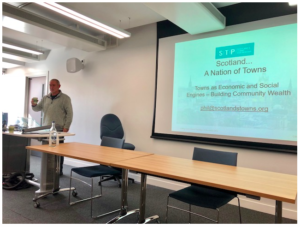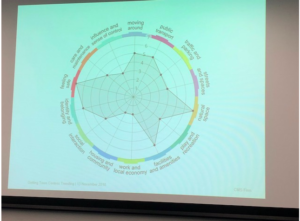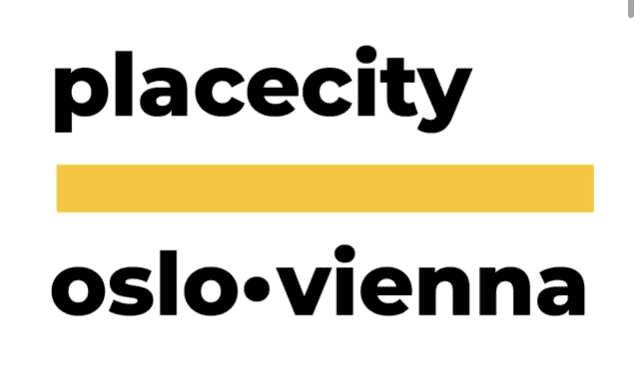At the end of November BIDs Belgium was invited to attend a workshop hosted by the London SchooI of Economics / University of London. To discuss and debate over the future of the BIDs at the BIDs Model workshop.
BIDs Belgium would be presenting the progress in Belgium with BIDs influenced ‘Puurgent’ and also a vision for the future, towards the end of the day.
In the meantime, there were many other interesting and varying models from across Europe.
With and intimate audience of practitioners and researchers from Scotland, England, Spain and Germany .
Each of the presentations showed the different levels and ways the BIDs have been developed.
The following run down is an excellent excerpt from Catherine Mitton, the Executive Director of the BIDs Foundation. Catherine wrote an article on Linkedin from our experience at the event. Therefore, rather than giving another run-down, we thought it best to share this detailed overview from Catherine, whom we were very pleased to meet at the event, explaining the ‘BIDs Models from 1.0 – 4.0’.

BIDS MODELS
The -1 Model
“The BID model isn’t currently in existence in Spain but there are over 400 town centre management initiatives, which have evolved since the 1990s, inspired by its success in the UK. Having none or ‘-1’ as we referred to it was not for lack of trying. The practitioners who deliver and manage them and the municipal authorities recognise that a new evolution of place management model is needed, noting that the majority of retailers and their current customers are an ageing population. In 20 years time, the people who use them will no longer be around resulting in current retail becoming surplus to requirements. Like the growth hub and spoke development of BIDs in the UK, Spain look to us and Germany to explore their options.
Spain believe introducing an occupier levy model on a 4 year term is the right route for them. Germany on the other hand has no occupier BIDs. They introduced laws allowing the development of property owner BIDs in 2005, with the investment contributing to infrastructure. There are fewer BIDs in Germany though compared with the UK, especially given the fact that we introduced legislation around the same time. Plus, despite their advancement compared with Spain, Sebastian from Hamburg stated that the model still faces challenges today including defining the geographical area, providing additionallity and no mechanism is in place to collect unpaid levies. Interestingly their approach on feasibility of a BID is refreshing and something we should perhaps be considering in the UK – at least 15% of property owners have to respond to wanting a BID in the first place before a ballot can be moved forward. Spain are aiming for 33% support pre-ballot. That is one hell of a feasibility study and rather ambitious given the majority turnout for first ballots in the UK is 44%. But, I can see the benefit of seeking this confirmation early on – it can help secure an overall majority and drive turnout.
Another point I like about our Spain’s proposals is that their municipal authority would not be entitled to cast votes in the ballot and their reasons behind this are simple. Helena and Luisa explain that this will help demonstrate that the private sector is in charge and argue that a municipals involvement could result in politicians pursuing their own agenda (sounds familiar)! But to counteract the argument that the municipal should be involved in place-making decisions, they will be allowed one non-voting director on the BID Board to ensure decisions are being made in the interest of its people and place.
So what’s stopping Spain?
Fear.
Fear from the government for being accused of increasing tax and being too interventionist. Fear from retailers that they will lose their jobs and businesses. I would argue that there is a fear of being left behind if they don’t do something soon. But, there are some complex legal issues to address first as there is no legislation in place and the scope of powers of municipals voting varies across regions, meaning only Madrid and Barcelona can contemplate a BID right now and they are doing just that by launching pilot schemes. Whatever the future holds for Spain, I am certain Helena, Luisa and team will ensure that they reach 1.0 before too long.
The 1.0 – 3.0 Model
I was pleased to present data commissioned by The BID Foundation, delivered by the IPM to the audience. My colleagues  were frantically updating the sample up to 24 hours before the workshop so I could present the latest statistics. When I began my presentation, I warned the delegates that the number of BIDs stat could change from 311 by the end of the day as we eagerly awaited the outcome of Yorkshire Coast and Blyth as proposed new BIDs and the result of Kendal’s first renewal ballot, demonstrating the fast and ever-changing dynamics of the UK landscape. Also representing the UK contingent on the agenda were BID practitioners from Camden and Euston BIDs, NE1 in Newcastle and Liverpool.
were frantically updating the sample up to 24 hours before the workshop so I could present the latest statistics. When I began my presentation, I warned the delegates that the number of BIDs stat could change from 311 by the end of the day as we eagerly awaited the outcome of Yorkshire Coast and Blyth as proposed new BIDs and the result of Kendal’s first renewal ballot, demonstrating the fast and ever-changing dynamics of the UK landscape. Also representing the UK contingent on the agenda were BID practitioners from Camden and Euston BIDs, NE1 in Newcastle and Liverpool.
Camden shared a refreshing and passionate perspective on the flexibility of the BID model expressing that the only barrier to growth is imagination, with BIDs often being the research and training ground for project delivery, thus alleviating the local authorities from taking risks. Hasanul shared Camden and Euston’s ambitions and past successes from its early ‘1.0 clean and green’ agenda through to ‘2.0 strategy, lobbying and ROI’ to innovative and income generating delivery, creating  jobs and developing skills – the 3.0 model. For example, its Collective project raised £1.3 million with joint funding from the BID, local council and the Greater London Authority and has delivered 7 co-working and pop-up hubs.
jobs and developing skills – the 3.0 model. For example, its Collective project raised £1.3 million with joint funding from the BID, local council and the Greater London Authority and has delivered 7 co-working and pop-up hubs.
Although I like the “your imagination is only your limitation” viewpoint, arguably having the right people and skills delivering in the first place is vital to success. And the number of people we have entering the industry limits this. Something Scotland know only too well. Yet, Phil Prentice who has led a strategic shift in the Scottish governments thinking on towns, moving from a siloed structure to a “Town Centre First Approach”, means Scotland are advocates of a holistic model  encouraging place practitioners to use data to understand the characteristics and demographics of towns to shape their futures. Something my colleagues at IPM promote widely, which we coin as ‘evidence based decision making’. They’ve been busy working with several stakeholders on bringing big data to small users (#BDSU). In summary, IPM is developing a dashboard that will enable place practitioners to use data to make informed and collaborative decisions about the future of their town and city centres.
encouraging place practitioners to use data to understand the characteristics and demographics of towns to shape their futures. Something my colleagues at IPM promote widely, which we coin as ‘evidence based decision making’. They’ve been busy working with several stakeholders on bringing big data to small users (#BDSU). In summary, IPM is developing a dashboard that will enable place practitioners to use data to make informed and collaborative decisions about the future of their town and city centres.
The 4.0 Model
Similarly, Scotland have just introduced a toolkit, which allows their towns to do just that. It is based on 7 interventions across 250 KPIs that include making places more attractive, accessible etc. Phil  explained that much like America, business owners in Scottish cities and towns live in the suburbs so don’t know the first thing about what’s needed in their town, city or street and why the place first principal is an approach Phil believes in and has been endorsed by the Scottish minister. All in part of a journey towards a different kind of BID model, perhaps even 4.0? You see Scotland has launched the toolkit on a brand new website (check it out, its brilliant) with a rebrand too. Scotland has made the decision to drop the ‘B’ (and I wish I was talking Brexit) and name themselves ‘Scotland Improvement Districts’ as they’re looking at models, which concentrate on all types of investment from the well known tourism/district models to community and even energy (Grangeworth). There are 60 in development at the moment so Scotland are tanking ahead with this approach but their legislation is more flexible than England. That said, this approach and language is also being explored elsewhere in the UK and further afield. Newport in Wales is embarking on introducing a digital improvement district and Camden revealed their plans for an ‘innovation district’ next month. So it is
explained that much like America, business owners in Scottish cities and towns live in the suburbs so don’t know the first thing about what’s needed in their town, city or street and why the place first principal is an approach Phil believes in and has been endorsed by the Scottish minister. All in part of a journey towards a different kind of BID model, perhaps even 4.0? You see Scotland has launched the toolkit on a brand new website (check it out, its brilliant) with a rebrand too. Scotland has made the decision to drop the ‘B’ (and I wish I was talking Brexit) and name themselves ‘Scotland Improvement Districts’ as they’re looking at models, which concentrate on all types of investment from the well known tourism/district models to community and even energy (Grangeworth). There are 60 in development at the moment so Scotland are tanking ahead with this approach but their legislation is more flexible than England. That said, this approach and language is also being explored elsewhere in the UK and further afield. Newport in Wales is embarking on introducing a digital improvement district and Camden revealed their plans for an ‘innovation district’ next month. So it is  easy to put these different models into boxes or numbers in this case but the main take-home message from the workshop is that not one size fits all when it comes to BIDs or IDs. It fundamentally has to work for the place but more importantly the people.
easy to put these different models into boxes or numbers in this case but the main take-home message from the workshop is that not one size fits all when it comes to BIDs or IDs. It fundamentally has to work for the place but more importantly the people.
Although BIDs Belgium was established 2 years ago, no federal legislation has been introduced to create BIDs. Their legislative system is even more complex than Spain with 19 mayors alone in Brussels and 6 governments in the country. They have introduced some very interesting delivery models including Puur Gent, which started with 500,000 euros 3 years ago and has trebled its investment to 1.5 million euros today. Rozina Spinnoy explained that despite their complex legal system they have the power and support of the EU collective, working holistically, redesigning places by reviewing the systematic changes happening in society today. The future of work, retail, healthcare etc. could be anything so we need to build a more inclusive and collaborative economy taking a citizen first, place first view.
Being based in Brussels, BIDs Belgium has the ear of many influential organisations including the United Nations and we ended the day not only having made connections but a will and agreement to explore collaborating as countries to tackle societal changes together and build and manage places that are for people first.
I am looking forward to picking up this conversation with my new found connections in the New Year and it provides a little comfort that whatever 29th March 2019 brings for the UK, our neighbours still want to work with us. Who knows, we may even end up with more than ‘nil point’ at Eurovision!
But as it was said earlier, we are only limited by our imagination. BIDs, IDs, places are evolving…we’re entering a new chapter but only we, as practitioners, can write the story.”
Thank you Catherine for this super run down. BIDs Belgium is also looking forward to entering into a new chapter and writing the story together with you all.
Also a big thank you to Giulia Faggio and all at London School of Economics for the invite and organisation of this event.






